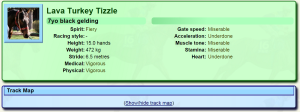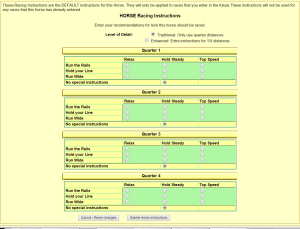This is one of the hardest and most personal parts of the game.
There are many schools of thought on this subject and many conflicting Theories and Styles of Play.
RIs should be set based on an average distance and ground that a horse will run on. If you happen to be a player that runs the same horse over multiple distances, you are going to have a lot more work to do in this area. For newer players just stick to 1 distance.
Here is one of the JaneDoe Tutorial Videos that goes over some of what is in this guide.
 When you go to Race Instructions (Horse) you will be brought to this page, where you will get a choice to set the default instructions or ones for a particular race, if you are already in races.
When you go to Race Instructions (Horse) you will be brought to this page, where you will get a choice to set the default instructions or ones for a particular race, if you are already in races.
If you set the default with you having races assigned, the default instructions will not reset the waiting to race RIs.
Once you click on one, you will go to the next page.
 On this page you will see the stats of the horse and all its perinatal information.
On this page you will see the stats of the horse and all its perinatal information.
You will also see a Track Map. If you are in a Race when you open it, it will automatically set the track length to the length of the race. If you are setting the default the track will automatically start at 800m. But you can set the distance to any distance you want using the up and down arrows.
The race will divide the race up into the 4 quarters so that you can see where the bends and straight-a-ways are.
Many players will define their Holds and Relaxes based on where the straights and turns are in the track for a particular distance.
 When you first start working on setting your RIs, they will all be set to “No Special Instructions”. This instructions will mean that the jockey RIs may take over or the horse will just do as it pleases. Some people never set RIs. So it will always be set at this level.
When you first start working on setting your RIs, they will all be set to “No Special Instructions”. This instructions will mean that the jockey RIs may take over or the horse will just do as it pleases. Some people never set RIs. So it will always be set at this level.
There are 9 other options for every section.
The first that we will talk about is the location to run on the track.
There are 26 lanes on a tack, 1 more than the maximum amount of horses that can be in a race (25 horses). Your gate position may be higher due to scratches but you will just be pushed closer to the gate with each scratch at the time of the race. This means that Lane #1 might be filled with horse #8.
 Run the Rails means the horse will tend to run close to the inside rail. This is a common and preferred location to run because it means that the horse has the least amount of distance to run in the race. (Horses will not always follow instructions
Run the Rails means the horse will tend to run close to the inside rail. This is a common and preferred location to run because it means that the horse has the least amount of distance to run in the race. (Horses will not always follow instructions
Hold your Line means the horse will hold whatever track line the horse is currently on. Due to the weaving and such that happens in a race, a horse will usually weave a bit when using this location on a track. IF the horse is on the rail, it doe snot mean that they will stick to the rail with this trait.
Run Wide means that the horse will run near or at the outside rail. This is the longest route that any horse can take in the race and is not often used by top players.
 Now we will talk about the 3 “Speeds” that a horse can run.
Now we will talk about the 3 “Speeds” that a horse can run.
Relax: This instruction will have the horse run as it desires with little to no prodding by the jockey. Often thought of as sitting like a lump of potatoes on the horse, but it can be useful if you need what is called a “strong” hold or rest during a race. This will often times be used in Cup heats to try to “save” the horse for the next week.
Hold Steady: This instruction will be used by the jockey to keep a steady pace, usually below the Top Speed, and Relax, but can take a bit out of a horse if the horse is wanting to run. This can sometimes me more taxing than Top Speed.
Top Speed: This trait will theoretically be where the horse runs the fastest they can. There can lots of variation to this speed, due to the horse’s energy reserves and Jockey RIs. This can take a lot out of a horse. If a horse is out of “steam” they could run slower in a Top Speed section of a race than in a Relax section of a race.
Now that we know the options we can start placing them on horses.
The first thing that you have to decide is are you going to use only quarter instructions or “Enhanced Instructions” which divides the race into 8ths.
The race length will evenly split the race so you can calculate how long each Quarter or Eighth is. Typically speaking I usually do Eighths, gives me a bit more flexibility in the race.
To decide how many Holds, Relaxes, and Top Speeds you should do, you should look at both your horse’s experience in that distance and Stamina values. There are a few ways you can go about deciding how many to do of what. Here are 2 of the more common ways to approach this.
- For every point of Stamina you have, you make that equal to 100m of a race on Dead track conditions that a horse can run Top Speed. When you get to epics this method goes out the window.
- This can be highly influenced by horse style, temperament, and ability to work with the Jockey.
- This can also be influenced by how much Distance and Ground Experience that a horse has.
- A horse running different Style to the Ground can get negative impacts, same with the other way around.
- You start with all Top Speed and see how far the horse lasts. Then in the next race you add a Hold or Relax and see how far the horse lasts in the next race, and so on until you get to the right amount of Relaxes, Holds, and Top Speeds.
- This method will take a fair bit of time to perfect, and if you are doing this on a horse is training, the ratio will change because the horse stats change.
- Ground and Distance Experience also play a heavy role here.
All of these methods will take time to figure out what is best for you and horses. Also remember that each horse is different and as you develop horses they will need different instructions. Also there are times that you don’t want to run as hard as a horse can. Times like prelims to cup races.


A good guide, I agree with this very well done
White Star Stables